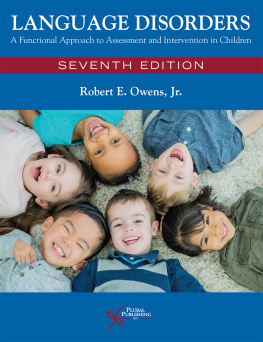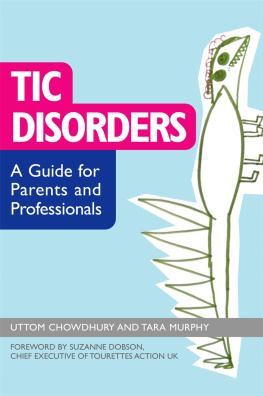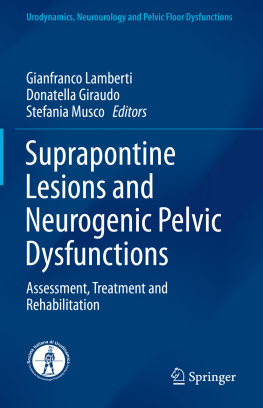


5521 Ruffin Road
San Diego, CA 92123
e-mail:
Website: https://www.pluralpublishing.com
Copyright 2024 by Plural Publishing, Inc.
Typeset 11/13 Adobe Garamond by Flanagans Publishing Services, Inc.
Printed in the United States of America by Integrated Books International
All rights, including that of translation, reserved. No part of this publication may be reproduced, stored in a retrieval system, or transmitted in any form or by any means, electronic, mechanical, recording, or otherwise, including photocopying, recording, taping, Web distribution, or information storage and retrieval systems without the prior written consent of the publisher.
For permission to use material from this text, contact us by
Telephone: (866) 758-7251
Fax: (888) 758-7255
e-mail:
Every attempt has been made to contact the copyright holders for material originally printed in another source. If any have been inadvertently overlooked, the publisher will gladly make the necessary arrangements at the first opportunity.
Library of Congress Cataloging-in-Publication Data:
Names: Hegde, M. N. (Mahabalagiri N.), 1941- author.
Title: A coursebook on aphasia and other neurogenic language disorders / M.N. Hegde.
Description: Fifth edition. | San Diego, CA : Plural Publishing, Inc., [2024] | Includes bibliographical references and index.
Identifiers: LCCN 2022035007 (print) | LCCN 2022035008 (ebook) | ISBN 9781635504224 (spiral bound) | ISBN 1635504228 (spiral bound) | ISBN 9781635504439 (ebook)
Subjects: MESH: Aphasia | Dyslexia, Acquired | Agraphia | Dementia
Classification: LCC RC425 (print) | LCC RC425 (ebook) | NLM WL 340.5 | DDC 616.85/52--dc23/eng/20220916
LC record available at https://lccn.loc.gov/2022035007
LC ebook record available at https://lccn.loc.gov/2022035008

The first edition of this book on aphasia and other neurogenic communication disorders was one of the first to be developed as a coursebook a new format for teaching and learning. Instructors and students alike have liked this format because it makes both teaching and learning a bit easier and more efficient than the traditional lecture method and classroom note-taking.
The coursebook format was originally designed as an effective instructional package that reduced the amount of note-taking needed. The coursebook also reduced the variability in the accuracy and completeness of notes students take. The use of this type of book promotes class discussion as the students are not as busy taking notes in the class as they otherwise would be.
My students who have used this book for the first time in a course I taught on aphasia and related communication disorders gave me much positive feedback. Students have found the coursebook a valuable means of integrating textbook information with class notes they take. They have a single source of information that is easier to study than a text on the (literally) one hand and the class notebook on the other. They have expressed a preference for this type of book for all of their courses. I would like to thank them for their comments and suggestions. I also welcome feedback from instructors who use this coursebook.
This fifth edition is not only a coursebook but also a stand-alone textbook on courses in aphasia and other neurologically based communication disorders, whether offered at the undergraduate or graduate level. This new textbook retains the coursebook format so the instructors can make lecture notes and students can write down instructors notes on the right half of each page of the text.
The text offers a comprehensive description and critical review of basic and applied information on aphasia, right hemisphere disorder, traumatic brain injury, and dementia the four major language and communication disorders associated with neurological pathologies. The relationship between the brain and language, major features of aphasia and other disorders, their assessment, and treatment have been described in streamlined and clinician-friendly language. Critical review of theories, assessment, and treatment research helps speech-language pathologists distinguish what is valid from the questionable in the professional and scientific literature. All assessment and treatment chapters give an outline of comprehensive and practical procedures, integrating current practices the clinicians might readily use.
New to the Fifth Edition
The new edition is a thorough revision of both the structure and content of the book. Several new topics and areas of research in understanding and treating the disorders are reviewed and critically evaluated:
Part I of the book has been restructured under the heading Brain and Language to describe the neuroanatomical bases of language and language impairments associated with neuropathological variables. Research on brain and language continues to use newer technologies producing a dynamic field of theories and applications. The chapter on neurodiagnostics has been revised and expanded to include a variety of surgical, radiological, and imaging procedures that help understand the relation between the brain structure and function and their involvement in language production and comprehension.
Part II has been reorganized into three chapters on aphasia. All major language intervention techniques are reviewed with outlined recommendations for clinicians.
Part III on the right hemisphere disorder consists of two chapters that have been revised to reflect current terminology, research, and clinical practice issues. Sections on neglect, deficit awareness, social communication, and abstract language intervention have been updated.
Part IV offers the most recent research on traumatic brain injury rehabilitation. Research on teaching compensatory strategies, group therapy, and community reentry has been updated with clinical recommendations.
Part V consists of two chapters on dementia with new information on changing incidence and prevalence patterns of dementia, infectious and rapidly progressive dementias, frontotemporal dementias, primary progressive aphasias, and HIV-associated neurocognitive disorders. An expanded clinical management and caregiver programs are included.
I am gratified that many instructors and students have found this innovative tool of teaching and learning useful and I am thankful for the many positive comments I have received from instructors across the country.
I am very pleased that this new edition is being published by Plural Publishing, the leading publishing house in communication disorders and related medical specialties. I would like to thank the editorial department headed by an able editor, Valerie Johns. Her kind and continuous help is greatly appreciated. I would also like to thank Lori Asbury, Production Manager and Jessica Bristow, Production Editor for their excellent help throughout the development and production process. Angie Singh, the president of Plural, has been a friend and supporter for decades. I thank her and all her efficient staff at Plural Publishing.

Next page









